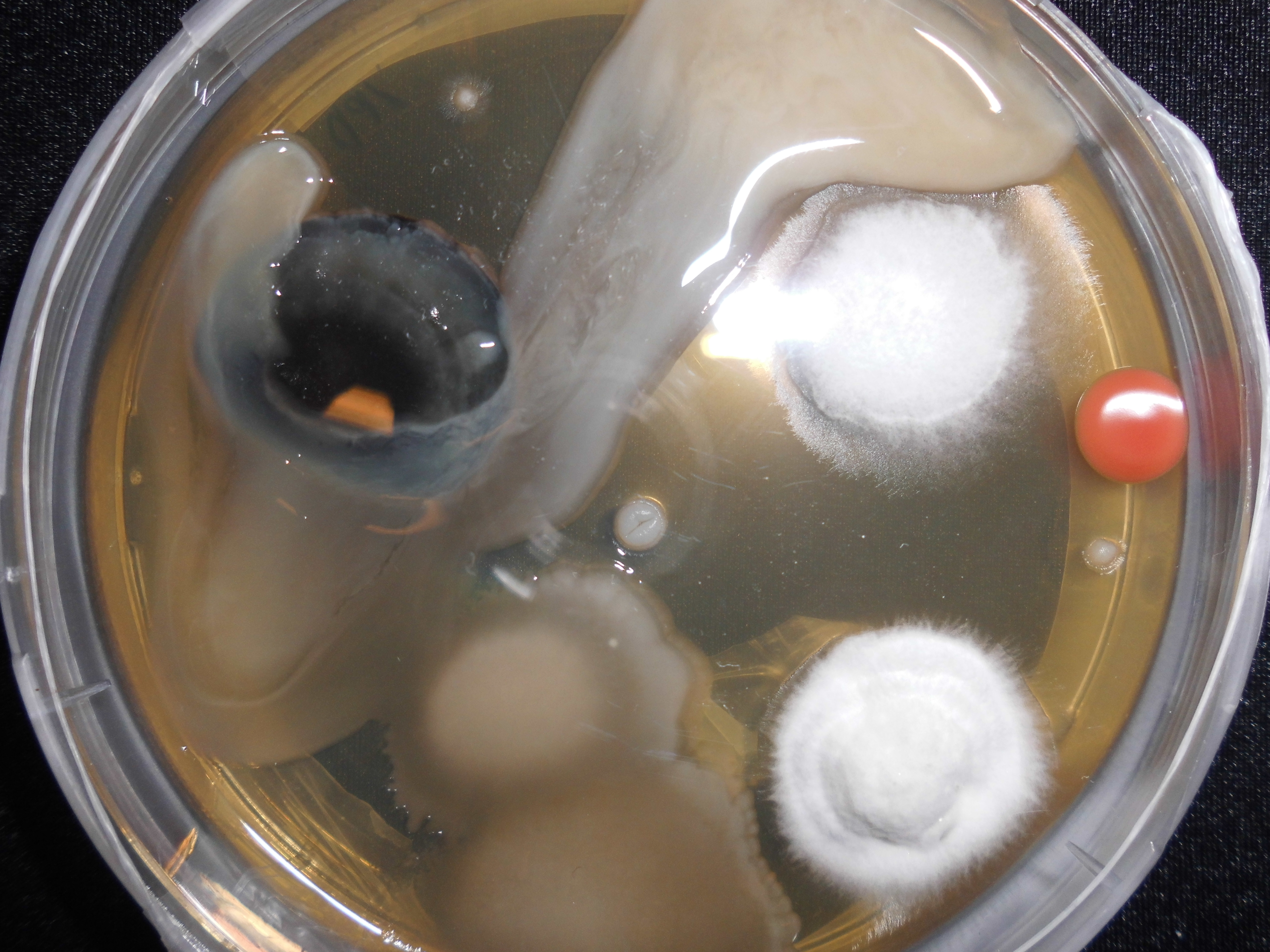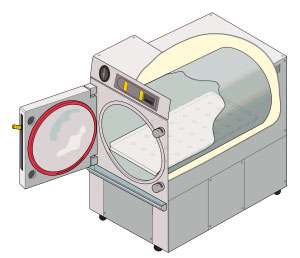|
Asepsis
Asepsis is the state of being free from disease-causing micro-organisms (such as pathogenic bacteria, viruses, pathogenic fungi, and parasites). There are two categories of asepsis: medical and surgical. The modern day notion of asepsis is derived from the older antiseptic techniques, a shift initiated by different individuals in the 19th century who introduced practices such as the sterilizing of surgical tools and the wearing of surgical gloves during operations. The goal of asepsis is to eliminate infection, not to achieve sterility. Ideally, an operating field is sterile, meaning it is free of all biological contaminants (e.g. fungi, bacteria, viruses), not just those that can cause disease, putrefaction, or fermentation. Even in an aseptic state, a condition of sterile inflammation may develop. The term often refers to those practices used to promote or induce asepsis in an operative field of surgery or medicine to prevent infection. History The modern concept of asepsis ... [...More Info...] [...Related Items...] OR: [Wikipedia] [Google] [Baidu] |
Sterilization (microbiology)
Sterilization () refers to any process that removes, kills, or deactivates all forms of life (particularly microorganisms such as fungi, bacteria, spores, and unicellular eukaryotic organisms) and other biological agents (such as prions or viruses) present in fluid or on a specific surface or object. Sterilization can be achieved through various means, including heat, chemicals, irradiation, high pressure food preservation, high pressure, and filtration. Sterilization is distinct from disinfection, sanitization, and pasteurization, in that those methods reduce rather than eliminate all forms of life and biological agents present. After sterilization, fluid or an object is referred to as being sterile or aseptic. Applications Foods One of the first steps toward modernized sterilization was made by Nicolas Appert, who discovered that application of heat over a suitable period of time slowed the decay of foods and various liquids, preserving them for safe consumption for a longer t ... [...More Info...] [...Related Items...] OR: [Wikipedia] [Google] [Baidu] |
Surgery
Surgery is a medical specialty that uses manual and instrumental techniques to diagnose or treat pathological conditions (e.g., trauma, disease, injury, malignancy), to alter bodily functions (e.g., malabsorption created by bariatric surgery such as gastric bypass), to reconstruct or alter aesthetics and appearance (cosmetic surgery), or to remove unwanted tissue (biology), tissues (body fat, glands, scars or skin tags) or foreign bodies. The act of performing surgery may be called a surgical procedure or surgical operation, or simply "surgery" or "operation". In this context, the verb "operate" means to perform surgery. The adjective surgical means pertaining to surgery; e.g. surgical instruments, operating theater, surgical facility or surgical nurse. Most surgical procedures are performed by a pair of operators: a surgeon who is the main operator performing the surgery, and a surgical assistant who provides in-procedure manual assistance during surgery. Modern surgical opera ... [...More Info...] [...Related Items...] OR: [Wikipedia] [Google] [Baidu] |
Infection
An infection is the invasion of tissue (biology), tissues by pathogens, their multiplication, and the reaction of host (biology), host tissues to the infectious agent and the toxins they produce. An infectious disease, also known as a transmissible disease or communicable disease, is an Disease#Terminology, illness resulting from an infection. Infections can be caused by a wide range of pathogens, most prominently pathogenic bacteria, bacteria and viruses. Hosts can fight infections using their immune systems. Mammalian hosts react to infections with an Innate immune system, innate response, often involving inflammation, followed by an Adaptive immune system, adaptive response. Treatment for infections depends on the type of pathogen involved. Common medications include: * Antibiotics for bacterial infections. * Antivirals for viral infections. * Antifungals for fungal infections. * Antiprotozoals for protozoan infections. * Antihelminthics for infections caused by parasi ... [...More Info...] [...Related Items...] OR: [Wikipedia] [Google] [Baidu] |
Medical Glove
Medical gloves are disposable gloves used during medical examinations and procedures to help prevent cross-contamination between caregivers and patients. Medical gloves are made of different polymers including latex, nitrile rubber, polyvinyl chloride and neoprene; they come unpowdered, or powdered with corn starch to lubricate the gloves, making them easier to put on the hands. Corn starch replaced tissue-irritating lycopodium powder and talc, but even corn starch can impede healing if it gets into tissues (as during surgery). As such, unpowdered gloves are used more often during surgery and other sensitive procedures. Special manufacturing processes are used to compensate for the lack of powder. There are two main types of medical gloves: examination and surgical. Surgical gloves have more precise sizing with a better precision and sensitivity and are made to a higher standard. Examination gloves are available either sterile or non-sterile, while surgical gloves are generally ... [...More Info...] [...Related Items...] OR: [Wikipedia] [Google] [Baidu] |
Joseph Lister
Joseph Lister, 1st Baron Lister, (5 April 1827 – 10 February 1912) was a British surgeon, medical scientist, experimental pathologist and pioneer of aseptic, antiseptic surgery and preventive healthcare. Joseph Lister revolutionised the Surgical technique, craft of surgery in the same manner that John Hunter (surgeon), John Hunter revolutionised the science of surgery. From a technical viewpoint, Lister was not an exceptional surgeon, but his research into bacteriology and infection in wounds revolutionised surgery throughout the world. Lister's contributions were four-fold. Firstly, as a surgeon at the Glasgow Royal Infirmary, he introduced carbolic acid (modern-day phenol) as a sterilization (microbiology), steriliser for surgical instruments, patients' skins, surgical suture, sutures, surgeons' hands, and wards, promoting the principle of antiseptics. Secondly, he researched the role of inflammation and tissue perfusion in the healing of wounds. Thirdly, he advanced diag ... [...More Info...] [...Related Items...] OR: [Wikipedia] [Google] [Baidu] |
Johns Hopkins Hospital
Johns Hopkins Hospital (JHH) is the teaching hospital and biomedical research facility of Johns Hopkins School of Medicine in Baltimore, Maryland. Founded in 1889, Johns Hopkins Hospital and its school of medicine are considered to be the founding institutions of modern American medicine and the birthplace of numerous famed medical traditions, including rounds, residents, and house staff. Several medical specialties were founded at the hospital, including neurosurgery by Harvey Cushing and Walter Dandy, cardiac surgery by Alfred Blalock and Vivien Thomas, and child psychiatry by Leo Kanner. Johns Hopkins Children's Center, which serves infants, children, teens, and young adults aged 0–21, is attached to the hospital. Johns Hopkins Hospital is widely regarded as one of the world's greatest hospitals and medical institutions. For 21 consecutive years from 1991 to 2020, it was ranked as the best overall hospital in the United States by ''U.S. News & World Report''. In its 2019–20 ... [...More Info...] [...Related Items...] OR: [Wikipedia] [Google] [Baidu] |
Scrubs (clothing)
Scrubs, sometimes called surgical scrubs or nursing scrubs, are the sanitary clothing worn by physicians, nurses, dentists and other workers involved in patient care. Originally designed for use by surgeons and other operating room personnel, who would put them on when sterilizing themselves, or "scrubbing in", before surgery, they are now worn by many hospital personnel. Their use has been extended outside hospitals as well, to work environments where clothing may come into contact with infectious agents (veterinarians, midwives, etc.). Scrubs are designed to be simple (with minimal places for contaminants to hide), easy to launder, and cheap to replace if damaged or stained irreparably. In the United Kingdom, scrubs are sometimes known as theatre blues. The spread of methicillin-resistant ''Staphylococcus aureus'' (MRSA) has increased the use of scrubs but can give wearers a false sense of security that they are "clean" when in fact they are as easily contaminated as any ... [...More Info...] [...Related Items...] OR: [Wikipedia] [Google] [Baidu] |
Tennis Shoes
Sneakers (American English, US) or trainers (British English, UK), also known by a #Names, wide variety of other names, are shoes primarily designed for sports or other forms of physical exercise, but are also widely used for everyday casual wear. They were popularized by companies such as Converse (shoe company), Converse, Nike, Inc., Nike and Spalding (company), Spalding in the mid 20th century. Like other parts of the global clothing industry, shoe manufacturing is heavily concentrated in Asia with nine in ten shoes produced there. Names Sneakers have gone by a variety of names, depending on geography and changing over the decades. The broader category inclusive of sneakers is athletic shoes. The term 'athletic shoes' is typically used for shoes utilized for jogging or road running and indoor sports such as basketball, but tends to exclude shoes for sports played on grass such as association football and rugby football, which are generally known in North America as "Cl ... [...More Info...] [...Related Items...] OR: [Wikipedia] [Google] [Baidu] |
William Stewart Halsted
William Stewart Halsted, M.D. (September 23, 1852 – September 7, 1922) was an American surgeon who emphasized strict aseptic technique during surgical procedures, was an early champion of newly discovered anesthetics, and introduced several new operations, including the radical mastectomy for breast cancer. Along with William Osler (Professor of Medicine), Howard Atwood Kelly (Professor of Gynecology) and William H. Welch (Professor of Pathology), Halsted was one of the "Big Four" founding professors at the Johns Hopkins Hospital. His operating room at Johns Hopkins Hospital is in Ward G, and was described as a small room where medical discoveries and miracles took place. According to an intern who once worked in Halsted's operating room, Halsted had unique techniques, operated on the patients with great confidence and often had perfect results which astonished the interns. Throughout his professional life, he was addicted to cocaine and later also to morphine, which w ... [...More Info...] [...Related Items...] OR: [Wikipedia] [Google] [Baidu] |
Carbolic Acid
Phenol (also known as carbolic acid, phenolic acid, or benzenol) is an aromatic organic compound with the molecular formula . It is a white crystalline solid that is volatile and can catch fire. The molecule consists of a phenyl group () bonded to a hydroxy group (). Mildly acidic, it requires careful handling because it can cause chemical burns. It is acutely toxic and is considered a health hazard. Phenol was first extracted from coal tar, but today is produced on a large scale (about 7 million tonnes a year) from petroleum-derived feedstocks. It is an important industrial commodity as a precursor to many materials and useful compounds, and is a liquid when manufactured. It is primarily used to synthesize plastics and related materials. Phenol and its chemical derivatives are essential for production of polycarbonates, epoxies, explosives such as picric acid, Bakelite, nylon, detergents, herbicides such as phenoxy herbicides, and numerous pharmaceutical drugs. ... [...More Info...] [...Related Items...] OR: [Wikipedia] [Google] [Baidu] |
Autoclave
An autoclave is a machine used to carry out industrial and scientific processes requiring elevated temperature and pressure in relation to ambient pressure and/or temperature. Autoclaves are used before surgical procedures to perform sterilization and in the chemical industry to cure coatings and vulcanize rubber and for hydrothermal synthesis. Industrial autoclaves are used in industrial applications, especially in the manufacturing of composites. Many autoclaves are used to sterilize equipment and supplies by subjecting them to pressurized saturated steam at for 30–60 minutes at a gauge pressure of 103 kPa depending on the size of the load and the contents. The autoclave was invented by Charles Chamberland in 1879, although a precursor known as the steam digester was created by Denis Papin in 1679. The name comes from Greek ''auto-'', ultimately meaning self, and Latin ''clavis'' meaning key, thus a self-locking device. Uses Sterilization autoclaves are widely us ... [...More Info...] [...Related Items...] OR: [Wikipedia] [Google] [Baidu] |
Ernst Von Bergmann
Ernst Gustav Benjamin von Bergmann (16 December 1836 – 25 March 1907) was a Baltic German surgeon. He was the first physician to introduce heat sterilisation of surgical instruments and is known as a pioneer of aseptic surgery. Early life and education Born in Riga, Livonia Governorate (now Latvia), in 1860 he earned his doctorate at the University of Dorpat. He then worked as an assistant at the surgical clinic, and trained for surgery under Georg von Adelmann (his future father-in-law), and Georg von Oettingen. He received his certification in 1864. Career From 1871 to 1878 he was a professor of surgery at Dorpat. In 1878 he became a professor at Würzburg; in 1882 he relocated to the University of Berlin as a successor to Bernhard von Langenbeck. von Bergmann continued as a professor of surgery at Berlin for the remainder of his career. Two of his assistants in Berlin were Curt Schimmelbusch (1860–1895) and Friedrich Gustav von Bramann (1854–1913). [...More Info...] [...Related Items...] OR: [Wikipedia] [Google] [Baidu] |










